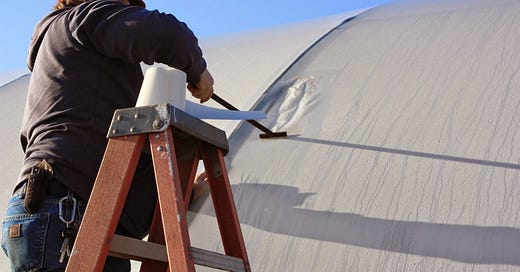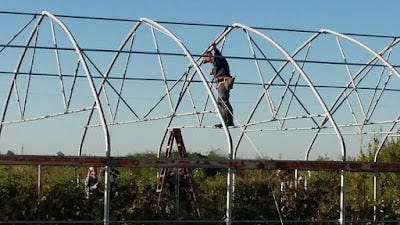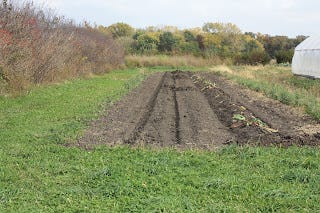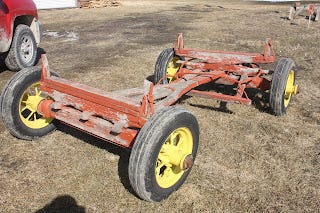It feels like it has been a while since I’ve provided readers with a farm update, so I thought I’d spend a few moments and put one together. I don’t feel much like writing a long introduction today, so let’s just get right to it, shall we?
But first, let me remind people that subscribing to the blog helps to encourage me to keep writing. In fact, if you find my work valuable, you can even pledge to support me with a paid subscription, should I decide to add that option in the future.
The Garlic Suppression Campaign at GFF
The early warm weather is something we haven't talked about too much in recent blog posts. So, I thought I’d give a specific examples of problems an early Spring can cause for us at the farm.
Looking back, we had a very early Spring in 2012 that resulted in some difficult losses with our garlic (see #4 on this post). Garlic was weeks ahead and their early emergence made them fair game for Aster Yellows, a disease that was transmitted by Leaf Hoppers. The end result was that the garlic would not store and we could not use any of our own seed for subsequent years.
If you need further translation, the crop was a near total loss. because of the disease.
Determined to avoid having the same problem, we decided to do something about it this year. Tammy and I went out and pushed all of those anxious little garlic plants BACK into the ground. We also made certain to give them a verbal admonition to wait "just a little bit longer - for your own good." Unfortunately, garlic does not have ears, so they must not have heard us and they popped back up the next day. It is also possible that a few of them will not be garlic plants anymore since they gave us the 'raspberry' when they popped back out of the ground.
High Tunnel Wrinkle Repair Underway
A good sunny day helps, but botox will not.
A couple of recent sunny days provided us with a much needed opportunity to do some outdoor activities on the farm. One of our normal Spring activities is to do routine maintenance on the high tunnel. Along with fixing breaks, tightening turnbuckles and preparing the soil, there is the annual job of ironing the plastic. This is one task we didn't count on when we first purchased the building, but I suppose we should have realized that the plastic would expand and contract given the temperature extremes it is forced to go through every year.
Since this Winter has been exceptionally warm - but with a very extreme two week period in the middle - the plastic is ... well... exceptionally wrinkly. We hope to get through a month or so before we replace the plastic, so we spent a good deal of time with a special ironing tool working the plastic back into shape. Failure to do so would result in inadequate light entering the tunnel, so this is a critical step for vegetable production this Spring.
We were so busy with the process that we neglected to get a picture showing you how we got the top of the tunnel completed. We'll try to show you a picture in the future.
One Phobia Beats Another
The Bandsaw Man is not too fond of heights. But, all I said was, “Look! A snake!”
Anonymous Farmer Project Includes Genuine Faux Farm
The Genuine Faux Farm has been selected to be a participant in a new project called the Anonymous Farmer Project. Since many people do not seem to place much importance on learning about where their food comes from, this project was created to reflect this common approach to food acquisition and consumption.
Photos were selected from those provided by participating farms and were placed on a calendar that can be found in the produce, fruit and meats section of many grocery stores throughout the nation. In every case, the farmer's identity is obscured - providing the consumer with an excellent excuse for not knowing who grew the food they have purchased or how it was raised.
Dyed Water to Get Colored Eggs
Our farm participates in many research projects. Some of them are of our own making, and this year is no exception. We have noticed that the composition of the eggs laid by our hens can change depending on what the birds ingest. For example, you might notice that the egg yolks become a richer yellow as they spend more outdoor time on green pastures and they fade a bit during the Winter. In fact, we've noticed a definite orange tinge to the yolks when we feed them squash.
If you need more evidence, let me point something out. What happens when you eat red beets?
I rest my case.
And I’m not going to mention the asparagus thing that happens. (If you know, you know)
After the recent egg sales for Easter, we realized we may have missed the boat on an opportunity here. Therefore, this Summer, we will segregate a small batch of chickens and put colored dye into their water. Can you imagine how convenient it would be for all of you to celebrate Easter with pre-dyed eggs?
The only problem with it is that we think this will dye the yolks and not the shells. Hopefully people will be happy when they crack open an egg and they have blue, green or red yolks. We just have to make sure we don’t mix colors wrong because I suspect brown might not be appreciated as much as other colors.
Our next step will be to figure out how to pre-hardboil the eggs. We're not sure the chickens are going to enjoy that experiment as much as this one.
Egg Filming In Progress
Iowa Public Television was once again at the Genuine Faux Farm to record supplemental footage for an upcoming show. GFF appeared several years ago on a show that featured the our ducks (which we no longer raise).
IPTV staff contacted us in hopes that we might have some fertilized eggs that could eventually hatch. Of course, we do have a rooster in our flock, so we responded in the positive. After all, the operative word in their request was "could." Maybe they could have if they hadn't already been put in the refrigerator - but the IPTV folks don't need to know that - so don't tell them.
The filming crew has been at the farm for the past four weeks, taking turns keeping the camera running just in case the eggs should begin to show signs of hatching. We suppose we should tell them at some point that these eggs needed to be in a warm environment for them to hatch, but when they aren't filming they've been pretty useful around the farm and we hate to lose the extra help.
Pre-Wilting Technique for Greens
Your farmers spend some time reading up on the newest techniques for production and harvest during the cold months of the year. One of the hot topics recently has been finding the best ways to deal with post-harvest handling of greens. Our farm has used hydro-cooling since 2007 in an effort to make it possible for lettuce and other similar veggies to last longer in your refrigerator and we feel we've been very successful with this process.
Please note the successful wilting in the row to the right.
Apparently, one of the newer techniques for producing high quality greens is to stop watering target plants long enough for the leaves to wilt. Once wilt is achieved, they are re-hydrated with a heavy irrigation pass prior to harvest.
The logic here is that those leaves that return to their prior picture of health were the ones most likely to last longer after cutting. In short, this removes any of the weaker leaves from harvest, resulting in the customer getting the best quality leaves from the plant.
Given the picture above, we can manage the wilting part. We're not sure if we've got the timing down for the rest.
Rhetorical Farm Cart
If a 'rhetorical question' does not require an answer, then it makes sense that a rhetorical farm cart does not need to carry any payload. Sometimes, it is all about the existence of the item and the point it is trying to make - at least that's what we've been told.
We purchased this new cart at an auction for $15. Why did we buy it? Well, we were running short on cash and needed an influx of money somehow...
Now, hear us out on this. Usually, a little cart like this, in good shape, with good tires, would cost a minimum of $100. Heck, we've seen a pile of tires go for $15. In fact, we've seen another running gear without a deck with similar characteristics go for a couple hundred dollars. At the very least, we figure we saved $50 on this rhetorical farm cart. So, technically, we are in the positive by $50 or more. We're still working out why the balance in the checking account went DOWN.
Litter Harvest Reaches New Record Levels
Apparently word has gotten out that our farm actually resides on one of the richest deposits of scoopable cat litter in the state. As a result, the demand has gone through the roof since its discovery.
In an effort to keep costs low, we've been re-using old litter buckets to harvest the pure, unrefined scoopable litter from the deposits deep in the earth.
Thus far, we have been only selling the litter 'ore' to larger refining companies, but we are considering working on setting up our own refinery so we can sell local scoopable cat litter direct to the consumer. The hardest part has been coming up with a name for the new product. We were sort of thinking about "True Grit" but are a little nervous that there might be some legal fall-out from John Wayne's estate.
Sadly, we had to move to a new vein last week after our outdoor cat farm managers discovered the initial lode.
Tiny House For Felines
You probably have noticed the 'tiny house' concept for humans - well, here is the next new thing for pets - the litter bucket tiny home! We read about cat lovers in a Chicago suburb placing litter buckets in the alleys and other locations where feral cats tend to be found. After all, those poor critters suffer in the elements too!
There have apparently been a few issues with this approach that have yet to be addressed. We have addressed one of them with Soup's personal 'tiny home' on the farm. You see, most of the buckets in Chicago were put out with the lids on. People were forgetting that cats do NOT have opposable thumbs and opening a lid is not likely to be easy for them. When asked about this, one person said they were worried that the open side would result in the cat getting wet in a driving rainstorm, so they wanted to leave the lid there as a 'door' that the cat could shut.
Our solution allows the cat to get in and out just fine. We figure if there is a driving rain coming in the opening, the cat can jump out quick and spin the bucket around in another direction.
There were several other problems noted with these tiny homes, but we'll let you figure out that bucket list on your own.
Weed Maze
GFF entered the world of agrotourism last year with its first annual weed maze. The anticipated opening of the maze is usually sometime in August when the foxtail, pigweed and giant ragweed have had a chance to reach their growth potential.
Tammy was quoted as saying that this would work better but “those pesky tomatoes weren't always in the way.”
Actually, last year’s attempt to have a weed maze was thwarted when the worker who was sent to mow the maze path was lost. Recent field clean up revealed that the worker had survived the mild winter, eating frozen tomatoes and field mice.
We Assume You Have Figured It Out By Now
Why yes... today IS April 1.
I hope you enjoyed today’s post! Have a good remainder of your day and a fine month with just the right amount of humor to keep you healthy and honest.













Thanks Rob! A good laugh makes any day better!!